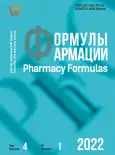Pharmacological potential of ligands to receptors of RF-amide neuropeptide system
- Authors: Yakovlev O.A.1, Vengerovich N.G.1,2, Nikiforov A.S.1, Vakhviyaynen M.S.1
-
Affiliations:
- State Scientific Research and Test Institute of Military Medicine, Ministry for Defense of the Russian Federation
- Saint Petersburg State Chemical Pharmaceutical University of the Ministry of Health of the Russian Federation
- Issue: Vol 4, No 1 (2022)
- Pages: 10-17
- Section: Pharmaceutical Sciences
- URL: https://journals.rcsi.science/PharmForm/article/view/108266
- DOI: https://doi.org/10.17816/phf108266
- ID: 108266
Cite item
Full Text
Abstract
The system of neuropeptides has a significant impact on different functions of the central nervous system, acting as a launching ground for the development of new generation drugs that have a complex therapeutic effect in mood disorders, nociception, reproductive behavior with minimal side effects, which is confirmed by the data of a number of preclinical studies. The review considers a promising neuropeptide system of the RF-amide family, which can become the basis for the development of new drugs, complementing the therapeutic possibilities of physiologically active substances with a more selective effect on certain pathological processes. The main groups of neuropeptides of the RF-system were identified: neuropeptides FF, 26 RF-amides, kisspeptins, prolactin-releasing and gonadotropin-inhibiting peptides. For each of these groups descriptions of biological effects are presented, including antinoceptive action, influence on the regulation of energy homeostasis, influence on reproductive behavior, etc. A number of non-peptide ligands for RF-amide receptors developed and available for research have been identified.
Full Text
##article.viewOnOriginalSite##About the authors
Oleg A. Yakovlev
State Scientific Research and Test Institute of Military Medicine, Ministry for Defense of the Russian Federation
Author for correspondence.
Email: gniiivm_15@mil.ru
Researcher at the Research Department
Russian Federation, Санкт-ПетербургNikolai G. Vengerovich
State Scientific Research and Test Institute of Military Medicine, Ministry for Defense of the Russian Federation;Saint Petersburg State Chemical Pharmaceutical University of the Ministry of Health of the Russian Federation
Email: nikolai.vengerovich@pharminnotech.com
ORCID iD: 0000-0003-3219-341X
SPIN-code: 6690-9649
Scopus Author ID: 55639823300
ResearcherId: U-3467-2019
http://eco.pharminnotech.com/sotrudniki-kafedry/vengerovic-nikolaj-georgievic
Doctor of Medical Science, Deputy Head of Department, Professor at the Industrial Ecology Department
Russian Federation, Санкт-ПетербургAleksandr S. Nikiforov
State Scientific Research and Test Institute of Military Medicine, Ministry for Defense of the Russian Federation
Email: gniiivm_15@mil.ru
SPIN-code: 3169-7701
Doctor of Biol. Sciences, Associate Professor, Leading Researcher
Russian Federation, Санкт-ПетербургMaria S. Vakhviyaynen
State Scientific Research and Test Institute of Military Medicine, Ministry for Defense of the Russian Federation
Email: gniiivm_15@mil.ru
junior researcher at the Research Department
Russian Federation, Санкт-ПетербургReferences
- Koroleva S. V., Ashmarin I. P. A functional continuum of regulatory anxiety-enhancing peptides. The search for complexes providing of the optimal basis for developing inhibitory therapeutic agents. Neuroscience and Behavioral Physiology. 2006;36;157-162. https://doi.org/10.1007/s11055-005-0174-2.
- Findeisen M., Rathmann D., Beck-Sickinger A. RFamide peptides: structure, function, mechanism and pharmaceutical potential. Pharmaceuticals. 2011;4(9):1248-1280. https://doi.org/10.3390/ph4091248.
- Quillet R., Ayachi S., Bihel S., et al. RF-amide neuropeptides and their receptors in Mammals: Pharmacological properties, drug development and main physiological functions. Pharmacology & Therapeutics. 2016;160:84-132. https://doi.org/10.1016/j.pharmthera.2016.02.005.
- Wang J. Q., Fibuch E. E., Sakurada S., et al. Anti-opioid peptides. In: Kastin A.J., ed. Handbook of Biologically Active Peptides. Cambridge, MA: Academic Press; 2006. 1641 p.
- Fang Q., Jiang T. N., Li N., et al. Central administration of neuropeptide FF and related peptides attenuate systemic morphine analgesia in mice. Protein Pept Lett. 2011;18:403-409.
- Lin Y. T., Yu Y. L., Hong W. C., et al. NPFFR2 activates the HPA axis and induces anxiogenic effects in rodents. International journal of molecular sciences. 2017; 18(8):1810-1821. https://doi.org/10.3390/ijms18081810.
- Du X., Pang T. Y. Is dysregulation of the HPA-axis a core pathophysiology mediating co-morbid depression in neurodegenerative diseases? Frontiers in psychiatry. 2015;6:32. https://doi.org/10.3389/fpsyt.2015.00032.
- Kim J. S., Brownjohn P. W., Dyer B. S., et al. Anxiogenic and stressor effects of the hypothalamic neuropeptide RFRP-3 are overcome by the NPFFR antagonist GJ14. Endocrinology. 2015;156(11):4152-4162. https://doi.org/10.1210/en.2015-1532.
- Geraghty A. C., Muroy S. E., Zhao S., et al. Knockdown of hypothalamic RFRP3 prevents chronic stress-induced infertility and embryo resorption. eLife. 2015;4:e04316. https://doi.org/10.7554/eLife.04316.
- Ayachi S., Simonin F. Involvement of mammalian RF-amid peptides and their receptors in the modulation of nociception in rodents. Frontiers in endocrinology. 2014;5:158. https://doi.org/10.3389/fendo.2014.00158.
- Leprince J., Bagnol D., Bureau R., et al. The Arg-Phe-amide peptide 26RFa/glutamine RF-amide peptide and its receptor: IUPHAR Review 24. British journal of pharmacology. 2017;174(20):3573-3607. https://doi.org/10.1111/bph.13907.
- Comninos A. N., Wall M. B., Demetriou L., et al. Kisspeptin modulates sexual and emotional brain processing in humans. The Journal of clinical investigation. 2017;127(2):709-719. https://doi.org/10.1172/JCI89519.
- Subbotina S.N., Yudin M.A., Parfyonova A.A., et al. Effects of Delta-sleep-inducing, Kisspeptin-10 and pt-141 Neuropeptides on Sexual Behaviour in Male Rats. Journal Biomed. 2021;17(1):43-56. https://doi.org/10.33647/2074-5982-17-1-43-56. (In Russ.).
- Nikitina I. L., Yuchlina Y. N., Sarakaeva L. R., et al. Modern concept of neuroendocrine and epigenetic regulation of the onset of puberty and sexual development. Translational studies on the role of the KISS/KISS1R system. Translational Medicine. 2020;7(5):62. https://doi.org/10.17816/RCF1243-12. (In Russ.).
- Tales M. G., Bianco S. D., Brito V. N., et al. A GPR54-activating mutation in a patient with central precocious puberty. N. Engl. J. Med. 2008;358:709-715. https://doi.org/10.1056/NEJMoa073443.
- Durnein C. I., Erb K., Flemming R., et al. Effects of recombinant LH treatment on folliculogenesis and responsiveness to FSH stimulation. Hum. Reprod. 2008;23(2):421-426. https://doi.org/10.1093/humrep/dem388.
- Kunes J., Prazienkova V., Popelova A., et al. Prolactin-releasing peptide: a new tool for obesity treatment // J Endocrinol. 2016. Vol. 230, no. 2. P. 51-58. https://doi.org/10.1530/JOE-16-0046.
- Prazienkova V., Popelove A., Kunes J., et al. Prolactine-releasing peptide: physiological and pharmacological properties. International journal of molecular science. 2019;20(21):5297. https://doi.org/10.3390/ijms20215297.
- Mankus J. V., McCurdy C. R. Nonpeptide ligands of neuropeptide FF: current status and structural insights. Future Med Chem. 2012;4(9):1085-1092. https://doi.org/10.4155/fmc.12.67.
Supplementary files















